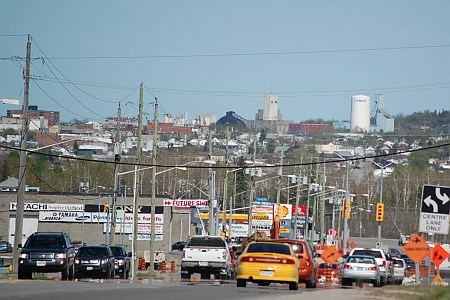The dark clouds sitting over the City of Timmins following the closure of Xstrata’s Kidd Creek Metallurgical site are beginning to lift as officials look for ways to diversify the local economy.
“Things are hard, but in reality, this is a positive time for Timmins,” says David McGirr, chair of the Timmins Economic Development Corporation (TEDC).
“There are a lot of people working hard to make sure things are moving forward, and there’s a lot of good news on the horizon.”
Some of those efforts revolve around helping to soften the blow of the 640 jobs lost at the Met site, which the city and the TEDC are working on collaboratively with other local partners.
Together, they’re looking to form a community adjustment committee to determine how to keep residents and small businesses alike in a better position to survive. This will consist of a series of local representatives, and will develop solutions for an action plan for the short term as well as in five, 10 and 15-year glances to the future.
The group will be overseen by a coordinator, as well as city and TEDC staff, who will be guided by the results of a study analyzing alternate uses for the Met site. Funding for the study has been provided by the province to the tune of $225,000, alongside $25,000 from the city.
Part of this approach involves further enhancing Timmins’ ever-growing mining exploration sector beyond traditional metals. To this end, the TEDC is also continuing to work with the Town of Kapuskasing on an ongoing industrial minerals project. Officials from both regions are looking to determine whether four separate deposits scattered between the two cities are sufficiently economic to consider marketing them to industrial mining firms around the world.
Comprised of slate, clay and soapstone, the four deposits are currently undergoing a study which should be completed by the fall.
The TEDC is also working with players from other prominent sectors as an investigation has begun into the potential to make use of biomass to generate energy.
Initially suggested by Marilyn Wood, co-owner of forest research firm Mikro-Tek and former Timmins Chamber of Commerce president, the idea is one that’s gained some traction.
After working with potential partners in the energy production sector in Canada and the United States, the TEDC developed a business plan and submitted it to the province in response to its wood supply competition, which closed in early May.
Though details about the project will remain scarce until September, when an answer will be provided by the Ministry of Northern Development, Mines and Forestry, McGirr says the TEDC is optimistic about its chances.
This focus on biomass doesn’t include the flurry ofinterest the region has seen from private sector developers looking to establish their own green energy projects within city limits, says Mark Jensen, director of development services with the City of Timmins.
In recent months, the city has fielded many phone calls and has held several meetings with companies curious about the potential to put down roots in the region.
These kinds of initiatives are creating a response from the region’s educational institutions, such as Northern College, which is slated to unveil an alternative energy technician program in the fall of 2011.
This will join some of the apprenticeship programs the school will introduce this fall, including heavy-duty equipment mechanic, millwright and carpentry.
Such growth is a direct response to the rising swell of demand from the community, as evidenced by a 47 per cent growth in first-year enrolment through 2009.
It’s this kind of proactive approach that will help to carry the city through the future, and it’s one that’s already bearing fruit, says Mayor Tom Laughren.
“Despite the recession, the forestry issue, and the closure of the Met site, Timmins has done well, and it’s the envy of many North American jurisdictions,” says Laughren. “We will find jobs to replace those lost, andwe’ll diversify beyond our natural resources.”
Laughren says he uses feedback from the Timmins Square shopping centre management as a barometer of the city’s economic health, and by those metrics, the city’s doing well, he says.
The Timmins Square currently has a 98 per cent occupancy, which exceeds the industry benchmark of 95 per cent. In 2009, the shopping centre processed $678,000 in gift certificates, and many of the stores are achieving 136 per cent to 162 per cent of their sales targets up to May 2010.
“Timmins’ future is bright,” says Laughren.




